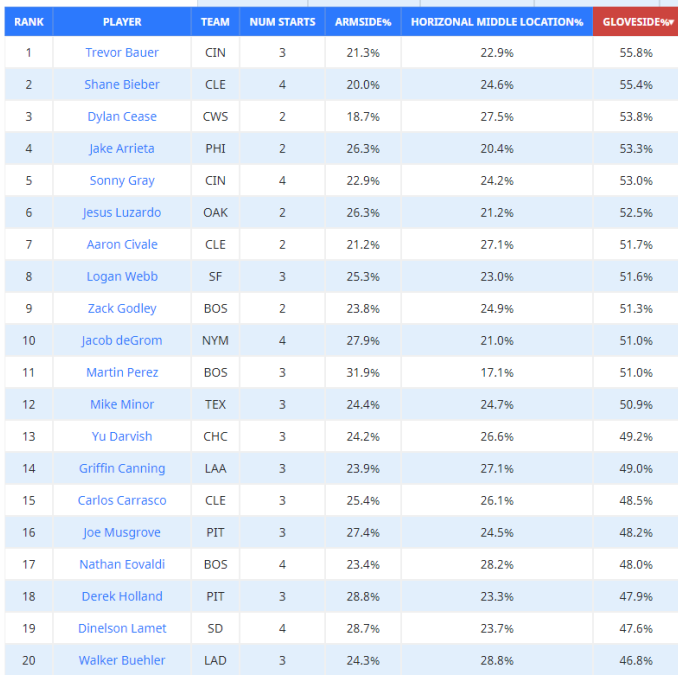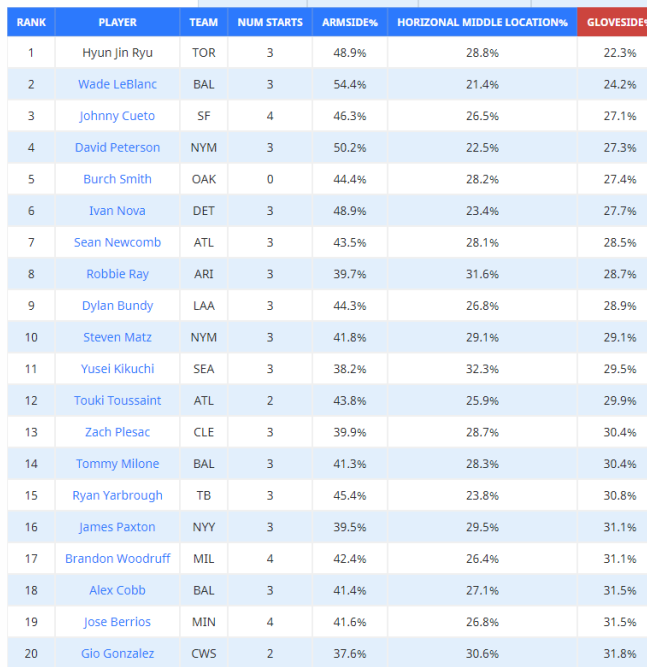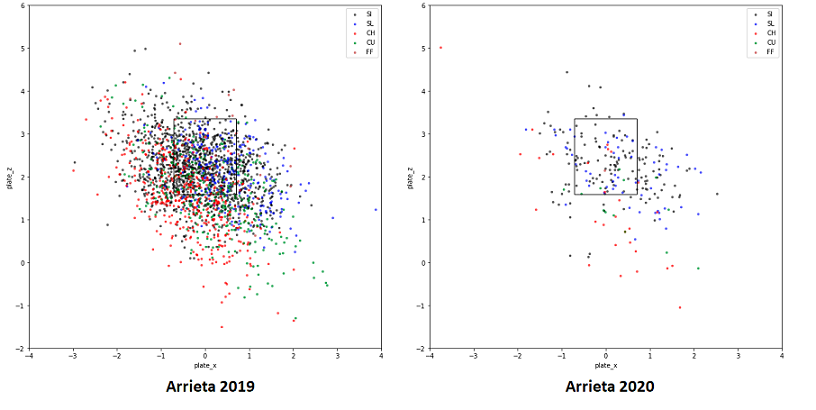Typically, the new school approach in baseball is just a different version of the old school. “He squares it up better than just about anybody” isn’t far off from “his barrel rate is better than 70% of the league.” A guy who “has a great eye” isn’t any different than “his chase rate is five points better than average.” If anything, the old school statement sets up the new school one. It’s like the first step in a conversation. And the first step in a conversation always has the ability to accurately frame the whole thing.
This sentiment is what makes something like glove side percentage for pitchers so intriguing. Glove side percentage, very plainly, it’s a stat that tells us how often a pitcher puts his pitches over the plate and toward his glove side. For righties, it’s to the first base side. For lefties, it’s the third base side. The way it contextualizes a pitcher’s approach is fascinating. Just think — so often we talk about tweaks a guy has made to his pitch mix, or how a new pitch is like a new truth he’s wielding as he mows down hitters. But in a lot of respects we’re still only describing individual puzzle pieces when we do that. We’re not really describing the picture we can see when the pieces are together. Consider these screen caps Nick recently shared in our discord, first showing in the far right column who most threw to the glove side early on, and then who was doing it least:


The minimum requirement for innings pitched was just 10, but it’s quickly instructive. Even Nick’s comment was that “there’s clearly a difference here.” The guys leaning into their glove side offerings the most are some of the most dominant pitchers in the league. The ones who have some of the lowest glove side rates are among the finesse guys who largely fall toward the back end of the rotation. There are natural tips about pitch mixes here, too. Sliders and cutters have natural glove side break and are often used to coax whiffs. Changeups and two-seamers have natural arm side break and are designed for weak contact. Just one number — glove side percentage — quickly shines a bright light on who leans on what and how it might represent their plan of attack.
Now let’s think about which starters are really leaning into which offerings and plans of attack this year. Below is a chart of the starting pitchers who have added the most glove side pitches in 2020, compared to 2019:
| Pitcher | 2019 Glove Side % | 2020 Glove Side % | % Increase |
|---|---|---|---|
| Glasnow, Tyler | 21.7 | 54.6 | 32.9 |
| Cease, Dylan | 26.7 | 53.9 | 27.2 |
| Civale, Aaron | 26.2 | 49.4 | 23.2 |
| Odorizzi, Jake | 30.6 | 53.3 | 22.7 |
| Arrieta, Jake | 24.2 | 46.5 | 22.3 |
| Bauer, Trevor | 32.9 | 54.2 | 21.3 |
| Eovaldi, Nathan | 29.5 | 50.7 | 21.2 |
| Plutko, Adam | 35 | 55.3 | 20.3 |
| Junis, Jakob | 26 | 45.4 | 19.4 |
| Gray, Sonny | 33.4 | 52.3 | 18.9 |
| Minor, Mike | 32.5 | 50.7 | 18.2 |
| Mills, Alec | 23.2 | 41.2 | 18 |
| deGrom, Jacob | 36.4 | 53.9 | 17.5 |
| Buehler, Walker | 32 | 48.6 | 16.6 |
| Musgrove, Joe | 30.2 | 46 | 15.8 |
| Darvish, Yu | 32.4 | 46.6 | 14.2 |
| Bumgarner, Madison | 33.6 | 47.2 | 13.6 |
| Holland, Derek | 36.4 | 49.3 | 12.9 |
| Maeda, Kenta | 27.3 | 40.1 | 12.8 |
| Perez, Martin | 35.5 | 48.2 | 12.7 |
The table is again a unique collection of really different pitchers but, in that sense, it acts almost like a decision tree, pointing us toward who to look at and why. At the very least with this particular group, it’s possible we’re seeing guys leaning into what’s comfortable for them in a year that’s been anything but normal or cozy. At large, if you’ve ever wondered which pitchers are doing something differently but didn’t know where to start, this could be a huge help. You don’t need to be tuned into the right team broadcast or Twitter feed to catch it. You don’t need to be knee-deep in leaderboards and work backwards to find what a pitcher, or group of pitchers, could be doing to generate different results.
Now that we’ve got a specific starting point, with the general knowledge that guys who throw it glove side probably have a certain repertoire and are frequently some of the best in the league, let’s check out the strikeout rates of our biggest glove side gainers.
| Name | K% 2019 | K% 2020 | % Difference |
|---|---|---|---|
| Trevor Bauer | 27.80 | 43.60 | 15.80 |
| Sonny Gray | 29.00 | 37.20 | 8.20 |
| Aaron Civale | 20.30 | 24.2 | 3.90 |
| Jake Arrieta | 18.50 | 21.00 | 2.50 |
| Tyler Glasnow | 33.00 | 37.00 | 4.00 |
| Joe Musgrove | 21.90 | 25.00 | 3.10 |
| Kenta Maeda | 26.20 | 28.70 | 2.50 |
| Nathan Eovaldi | 21.60 | 22.90 | 1.30 |
| Jacob deGrom | 31.70 | 32.60 | 0.90 |
| Mike Minor | 23.20 | 23.60 | 0.40 |
| Jake Odorizzi | 27.10 | 26.70 | -0.40 |
| Martin Perez | 17.80 | 16.50 | -1.30 |
| Yu Darvish | 31.30 | 29.60 | -1.70 |
| Derek Holland | 25.00 | 21.90 | -3.10 |
| Adam Plutko | 17.50 | 13.50 | -4.00 |
| Walker Buehler | 29.20 | 21.30 | -7.90 |
| Madison Bumgarner | 24.10 | 15.70 | -8.40 |
| Dylan Cease | 24.90 | 15.50 | -9.40 |
| Alec Mills | 29.90 | 19.40 | -10.50 |
| Jakob Junis | 21.30 | 10.30 | -11.00 |
Look at the top of this list for K rate difference! Dope, dope, dope, dope, dope. Trevor Bauer and Sonny Gray being first and second could be indicative of a team that’s pushed a ton of its chips into player development at every level, and having seemingly hit the constantly moving target of what’s best for the player and what’s the best strategy. Bauer is pumping his four-seam fastball and cutter more than he ever has. Maintaining a K-rate that high would be historic, but it would likely still be excellent even after baking in some regression. For context, the league leader in strikeout percentage in each of the last five years has generally been between 34 and 36%, and Gerrit Cole led the majors last year at just shy of 40%. Gray has always been able to spin it, but now he’s employing that spin better than ever (skip to the 14 minute mark in that video to hear specifics) and it appears to also means pushing it glove side. This is the kind of organizational move that led me to boldly predict that these guys, along with teammate Luis Castillo, would all finish in the top five in Cy Young voting.
I discussed Aaron Civale a couple weeks ago, with the gist of his changes centering on trading in his fastball for more breakers after creating additional drop on his slider. Now he has three distinct breaking balls that act like the moving staircases at Hogwarts, forcing hitters into stumbling through ABs. The league average strikeout rate for pitchers is a hair over 22%. The bump he’s generated in whiffing guys has moved him from below average to above it, which is huge for a pitcher whose walk rates have always been tiny because it means he’s letting even fewer hitters reach base.
There have been points in the last two seasons where Jake Arrieta looked completely cooked, even as we knew he was dealing with injuries. While he didn’t get as many whiffs yesterday against the Cardinals, his early rebound in 2020 seems to be because of at least two things. First, he’s using his slider more in place of his changeup. After getting the least vertical drop on the pitch in his career in 2019, it’s back to more of what we’d expect, making it less Frisbee-like. That alone could be a plus because it’s less easily discernible to a batter’s eye when Arrieta’s other two pitches break back toward them, which leads us to the other change he’s made. He’s throwing his two-seamer way more glove side, basically backdooring righties and busting it in on lefties. His changeup is dropping beneath it with similar motion. Last year, he threw them both arm side. Check out this graphic from the catcher’s perspective to see how it looks, created by our own Richard Dzeng:

We had questions coming into 2020 about whether Tyler Glasnow could maintain his success as a two-pitch pitcher. So far, he has, though he’s only registered 15.1 innings across four starts. It’s worth noting here that the Rays are weird, though. We have no idea if they’ll continue to use Glasnow as a power long reliever, or if it’s just the plan for the sprint that is the 2020 season, or if they’ll suddenly decide he should actually be a lefty. No matter what, like Arrieta, he’s challenging hitters more by throwing his high-powered heater to the glove side paint and continuing to let his snappy curve drop right below the zone.
When it comes to how these five pitchers are attacking the zone, Pitching Ninja may have said it best:
Trevor Bauer, Slider, Cutter and Two Seamer, (overlay w/ tails). Throw em all on the outer third…and let em work. pic.twitter.com/10fWK63lG3
— Rob Friedman (@PitchingNinja) July 17, 2020
“Throw em all on the outer third…and let em work” might as well be the mantra for all these guys. They’re showing us how a deliberate plan to spin it glove side can enable success. Our leaderboard helps us track it and quickly digest which pitchers are potentially leaning into which offerings while gleaning information on their general approach. That gives us a sharp starting point and specific language to discuss all these dudes. Everyone wins!

Such a good article!